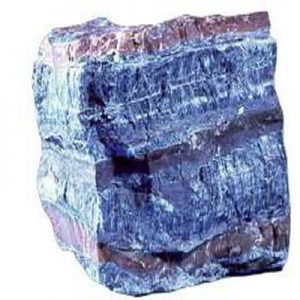Crocidolite
Crocidolite is just a fibrous, or asbestiform, variety of Riebeckite and belongs to the Amphibole Group of minerals which also includes Actinolite , Arfvedsonite, Riebeckite and Tremolite. Riebeckite types in alkalic granites and syenites while Crocidolite types in iron formations. Crocidolite was very first described in 1815 by M. H. Klaproth under the name Blaueisenstein meaning ironstone that is blue and in 1831 by J. F. Hausmann, who gave it its present name Crocidolite which will be from the Greek word kpokus meaning nap of cloth in allusion to its fibrous habit. Crocidolite fibers are finely hair-like and textured, occurring in naturally formed packages or mats. Its resemblance to asbestos has earned it the true title Cape Asbestos, the chief occurrence being in Cape Colony, South Africa. Crocidolite is created by geologic alteration by the reduction of alkali and peroxidation for the iron that is ferrous furher by deposition of silica between the materials or by their replacement by silica. A hard mineral that is siliceous formed that can be polished and exhibits a gorgeous chatoyance with silky luster and a smooth “cat’s eye” impact. This mineral becomes the most popular golden brown mineral understood as “tiger-eye” or “hawk’s-eye” when colored blue upon further alteration and deposition of silica. Another alteration item of Crocidolite, consisting of silica and ferric hydrate, is called Griqualandite for its occurance in the Asbestos Mountains, Griqualand West, Cape Colony, South Africa.
| Chemical Formula: | Na2Fe2+3Fe3+2(Si8O22)(OH)2 |
| Iron Sodium Silicate Hydroxide | |
| Molecular Weight: | 935.90 gm |
| Composition: | Sodium | 4.91 % | Na | 6.62 % | Na2O |
| Iron | 29.84 % | Fe | 23.03 % | FeO / 17.06% Fe2O3 | |
| Silicon | 24.01 % | Si | 51.36 % | SiO2 | |
| Hydrogen | 0.22 % | H | 1.92 % | H2O | |
| Oxygen | 41.03 % | O | |||
| 100.00 % | 100.00 % | = TOTAL OXIDE |
| Crystallography: | Monoclinic – Prismatic |
| Crystal Habit: | As prismatic crystals, to 20 cm. Commonly fibrous, asbestiform; earthy, massive. |
| Twinning: | Simple or multiple twinning || {100}. |
| Cleavage: | Perfect on {110} intersecting at 56° and 124°; partings on {100}, {010} |
| Fracture: | Conchoidal to Uneven, Splintery |
| Tenacity: | Brittle |
| Moh’s Hardness: | 5.0 – 6.0 |
| Density: | 3.28 – 3.44 (g/cm3) |
| Luminescence: | None |
| Radioactivity: | Not Radioactive |
| Other: | An asbestos mineral. Fibres, if breathed in, can cause serious and irreversable lung damage. Avoid exposure to dust. |
| Color: | Gray-Blue to leek-Green |
| Transparency: | Semi-transparent to Opaque |
| Luster: | Vitreous to Silky |
| Refractive Index: | 1.656 – 1.740 Biaxial ( + ) or ( – ) |
| Birefringence: | 0.005 – 0.008 |
| Dispersion: | Strong |
| Pleochroism: | X = blue, indigo; Y = yellowish green, yellowbrown; Z = dark blue |
| Other: | Exhibits chatoyance and cat’s eye effect |


